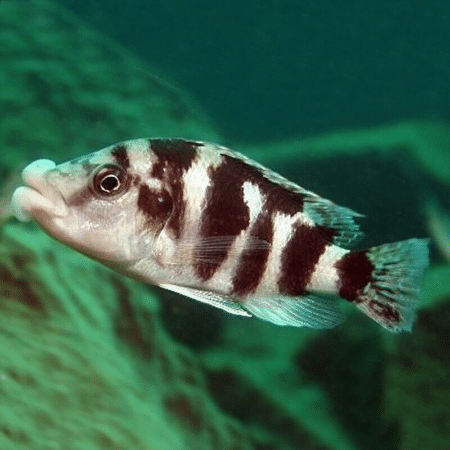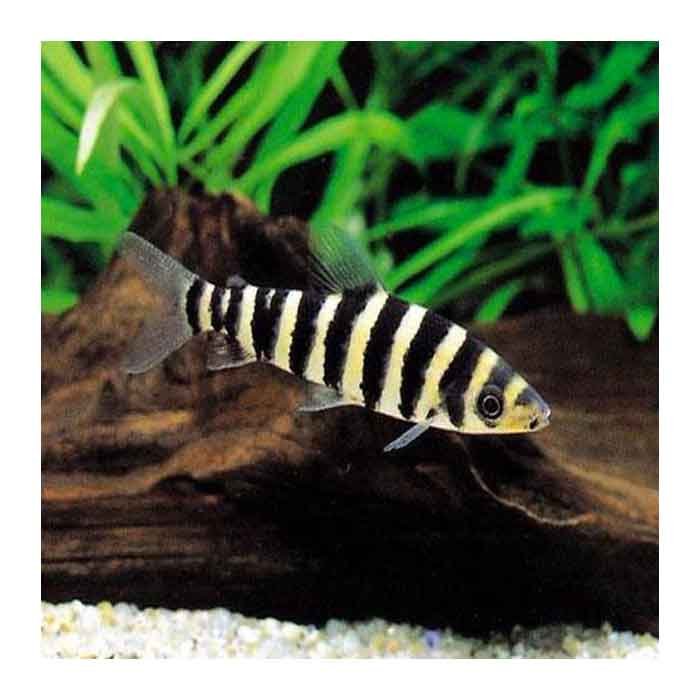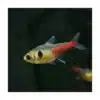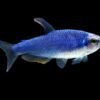Subtotal: £14.52
Banded Leporinus: A Striking and Energetic Aquarium Inhabitant Scientific Name: Leporinus affinis, Stunning Freshwater Fish for Beginners and Enthusiasts
£14.99 Original price was: £14.99.£12.58Current price is: £12.58.
Welcome the Banded Leporinus (Leporinus affinis), a stunning addition to your aquarium. With their vibrant stripes and energetic nature, these beautiful inhabitants thrive in community tanks. Perfect for aquarists seeking colorful fish that add elegance and beauty to any freshwater setup.
996 in stock
Species Introduction
The Banded Leporinus, scientifically known as Leporinus affinis, is a captivating species of freshwater fish that hails from the lush waters of South America. This vibrant fish is renowned for its striking appearance, characterized by a series of bold black bands against a shimmering silver body. These fish are typically found in slow-moving rivers and streams, where they inhabit areas rich in vegetation and submerged structures. The Banded Leporinus is not just a visual delight but also an energetic swimmer, making it a popular choice among aquarium enthusiasts. Their lively nature and schooling behavior add a dynamic element to any tropical aquarium setup.
Care Requirements Dashboard
✓ Care Level: Moderate
Tank Size: Minimum 30 gallons
Water Temperature: 75-82°F (24-28°C)
pH Level: 6.0-7.5
Water Hardness: 5-20 dGH
Natural Behavior & Temperament
The Banded Leporinus exhibits a playful and energetic temperament, making it a delightful addition to a community tank. These fish are known for their schooling behavior, thriving in groups of six or more. In their natural habitat, they are often seen darting through the water, foraging for food among plants and rocks. Their social nature means they are best kept with other peaceful fish, as they can become territorial when kept in smaller groups. Observing their interactions can be quite fascinating, as they establish a hierarchy within their school. This lively behavior not only enhances their appeal but also contributes to a vibrant aquarium environment.
Tank Setup Guide
Creating an ideal environment for your Banded Leporinus involves replicating their natural habitat as closely as possible. A tank of at least 30 gallons is recommended to provide ample swimming space. The substrate should consist of fine gravel or sand, allowing for easy movement and foraging. Incorporating plenty of plants, driftwood, and rocks will not only enhance the aesthetic appeal of your aquarium but also provide hiding spots and territories for the fish. When arranging decorations, ensure that there are open swimming areas, as Banded Leporinus enjoy darting about. Additionally, a good filtration system is essential to maintain water quality, as these fish prefer clean, well-oxygenated water.
Water Quality Management
Maintaining optimal water quality is crucial for the health and well-being of your Banded Leporinus. These fish thrive in a pH range of 6.0 to 7.5, with a water hardness of 5 to 20 dGH. The ideal temperature for their habitat is between 75°F and 82°F (24°C to 28°C). Regular water changes of 20-30% weekly will help keep nitrate levels low and maintain a stable environment. It’s also important to monitor ammonia and nitrite levels, ensuring they remain at zero. Using a high-quality water conditioner can help remove harmful chemicals and improve the overall quality of the water. A reliable test kit is essential for tracking these parameters and ensuring a healthy environment for your aquatic companions.
Feeding & Nutrition
Feeding your Banded Leporinus a balanced diet is key to their health and vibrancy. These fish are omnivorous and will thrive on a varied diet that includes high-quality flake food, pellets, and frozen or live foods such as bloodworms, brine shrimp, and daphnia. It’s important to feed them small amounts two to three times a day, ensuring they consume all the food within a few minutes to prevent water quality issues. A well-rounded diet will not only enhance their coloration but also promote healthy growth and vitality. Regularly incorporating vegetable matter, such as blanched zucchini or spinach, can also provide essential nutrients and fiber.
Compatibility Guide
The Banded Leporinus is best suited for community tanks with other peaceful fish species. Ideal tank mates include other South American tetras, barbs, and peaceful cichlids. However, caution should be exercised when selecting tank mates, as their energetic nature can sometimes lead to territorial disputes, especially in smaller tanks. Avoid keeping them with overly aggressive species or fish that are significantly smaller, as they may become targets for bullying. A well-planned community tank with compatible species will create a harmonious environment where all fish can thrive together.
Health & Wellness
Monitoring the health of your Banded Leporinus is essential for ensuring a long and vibrant life. Common health issues include ich, fin rot, and other parasitic infections, which can often be prevented through proper care and water quality management. Signs of illness may include lethargy, loss of appetite, or visible lesions. Regularly observing your fish for any changes in behavior or appearance can help catch potential problems early. Providing a stress-free environment and maintaining stable water parameters will significantly reduce the risk of health issues. In case of illness, isolating affected fish and consulting with an aquatic veterinarian can help ensure proper treatment.
Breeding Information
Breeding Banded Leporinus can be a rewarding experience for dedicated aquarists. These fish are egg layers, typically spawning on flat surfaces or among plants. To encourage breeding, it is essential to provide a separate breeding tank with optimal conditions, including slightly warmer water and plenty of hiding spots. A ratio of one male to two females is recommended to promote successful breeding. After spawning, the adults should be removed to prevent them from eating the eggs. The eggs will hatch within 24 to 48 hours, and the fry can be fed infusoria or powdered fry food until they are large enough to consume finely crushed flakes. Proper care during this stage is crucial for ensuring healthy growth.
Acclimation Process
Introducing your Banded Leporinus to a new tank requires careful acclimation to minimize stress. Begin by floating the sealed bag containing the fish in the aquarium for about 15 minutes to equalize the temperature. After this, gradually mix small amounts of tank water into the bag over the course of an hour. This process helps the fish adjust to the new water parameters. Once acclimated, gently release the fish into the tank using a net to avoid adding any transport water that may contain harmful substances. Monitoring the fish closely for the first few days after introduction is essential to ensure they adapt well to their new environment.
Long-term Care
Caring for your Banded Leporinus over the long term involves regular maintenance and monitoring of their environment. These fish can live up to 10 years or more with proper care, so establishing a routine for water changes, feeding, and tank maintenance is crucial. Regularly checking water parameters and performing partial water changes will help maintain a stable and healthy environment. Additionally, providing a varied diet and monitoring their health will contribute to their longevity. Engaging with your fish through observation and interaction can also enhance their well-being and enrich your aquarium experience.
Natural Habitat Recreation
To create a biotope that reflects the natural habitat of the Banded Leporinus, consider incorporating elements typical of South American rivers. Use a sandy substrate, along with driftwood and rocks to mimic the riverbed. Adding live plants such as Amazon swords and floating plants can provide cover and enhance the aesthetic appeal of your aquarium. The inclusion of natural materials not only benefits the fish by providing hiding spots but also contributes to the overall health of the aquarium ecosystem by promoting beneficial bacteria growth. Lighting should be moderate to highlight the vibrant colors of the fish while supporting plant growth.
Seasonal Care Adjustments
As seasons change, so too should your care routine for the Banded Leporinus. In warmer months, ensure that the water temperature remains stable and does not exceed 82°F (28°C). This may require additional aeration or cooling methods if your tank is exposed to direct sunlight. During colder months, monitor the temperature closely, as drops can stress the fish. Adjusting feeding schedules to account for seasonal changes in activity levels may also be necessary, as fish may become less active in cooler temperatures. Regularly checking water parameters and maintaining a consistent routine will help your fish thrive year-round.
Expert Tips
For those looking to provide the best care for their Banded Leporinus, consider these expert tips. First, ensure that your tank is well-planted to provide both hiding spots and open swimming areas. This balance will help reduce stress and promote natural behaviors. Second, maintain a consistent feeding schedule with a variety of foods to keep your fish healthy and vibrant. Lastly, regular observation of your fish can help you catch any potential health issues early. Engaging with your aquatic companions can enhance your experience and foster a deeper appreciation for their beauty and behavior.
Troubleshooting
Encountering issues with your Banded Leporinus can be concerning, but many common problems can be resolved with proper care. If you notice signs of stress, such as hiding or erratic swimming, check water parameters immediately. High ammonia or nitrite levels can be detrimental to their health, so regular testing is essential. If your fish are not eating, consider adjusting their diet or checking for signs of illness. In cases of disease, isolating affected fish and treating them in a separate tank can help prevent the spread of illness. Keeping a detailed log of water parameters and fish behavior can also assist in identifying patterns and potential issues.
Scientific Background
The Banded Leporinus belongs to the family Anostomidae, which includes various species of tetras and other freshwater fish. This family is known for its unique adaptations to freshwater environments, including specialized feeding habits and social structures. The scientific study of Leporinus affinis has revealed insights into their behavior, habitat preferences, and ecological roles within their native environments. Conservation efforts are crucial for preserving their natural habitats, as many freshwater ecosystems face threats from pollution and habitat destruction. Understanding the scientific background of these fish enhances our appreciation for their role in biodiversity and the importance of responsible aquarium keeping.
Advanced Care Techniques
For experienced aquarists looking to take their care of Banded Leporinus to the next level, consider implementing advanced techniques such as breeding conditioning and biotope replication. Conditioning fish for breeding involves providing a high-quality diet rich in protein and ensuring optimal water conditions. Additionally, replicating their natural biotope with specific plants and substrates can enhance their well-being and encourage natural behaviors. Utilizing advanced filtration systems and monitoring water quality with precision can also lead to a healthier and more stable environment. Engaging in ongoing education about aquatic care and conservation can further enrich your experience as an aquarist.
Frequently Asked Questions
Q: What tank size is required for the Banded Leporinus?
The Banded Leporinus, scientifically known as Leporinus affinis, is a lively fish that thrives best in a spacious environment. A minimum tank size of 200 litres is recommended to accommodate their active swimming behaviour. Providing adequate space is crucial, as they can grow up to 15 cm in length and prefer a tank with dimensions that allow for swimming and hiding. A larger tank not only enhances their well-being but also helps maintain stable water parameters, which is vital for their health. If you plan to keep multiple Leporinus or other tank mates, consider increasing the tank size further to avoid overcrowding.
✓ Expert Tip
Incorporate plenty of hiding spots and open swimming areas to create a balanced environment for your Banded Leporinus.
Q: What water parameters do Banded Leporinus require?
Banded Leporinus thrive in water that is slightly acidic to neutral, with a pH range of 6.5 to 7.5. The ideal water temperature should be maintained between 24°C to 28°C. Regular water changes are essential to keep ammonia and nitrite levels at zero, with nitrates below 20 ppm for optimal health. Additionally, ensure that the water hardness is between 5 to 15 dGH. Monitoring these parameters is vital, as fluctuations can lead to stress or illness in your fish. Utilising a reliable water testing kit will assist in maintaining these conditions.
✓ Expert Tip
Consider using a quality aquarium heater and filtration system to maintain stable water conditions for your aquatic companions.
Q: How often should I feed Banded Leporinus?
Banded Leporinus are omnivorous and should be fed a varied diet to meet their nutritional needs. It is advisable to feed them once or twice daily, providing only what they can consume within a few minutes. A balanced diet can include high-quality pellets, flakes, and occasional treats such as frozen or live foods. Overfeeding can lead to water quality issues and health problems, so moderation is key. Observe their feeding habits to ensure they are consuming the food adequately without leftover debris.
✓ Expert Tip
Incorporate a variety of foods to enhance the colouration and health of your Banded Leporinus.
Q: What are the best tank mates for Banded Leporinus?
Banded Leporinus are generally peaceful but can be territorial, especially as they mature. Ideal tank mates include robust and similarly sized fish such as Tetras, larger Barbs, and Cichlids that are not overly aggressive. Avoid keeping them with slow-moving or smaller fish, as they may become targets for bullying. It is also wise to provide ample hiding spots and open swimming areas to help reduce stress and territorial disputes. Observing their interactions will help ensure a harmonious community tank.
✓ Expert Tip
Introduce new tank mates gradually to avoid territorial disputes and allow for acclimatisation.
Q: How do I properly acclimatise Banded Leporinus to my aquarium?
Acclimatising your Banded Leporinus is crucial to ensure their health and reduce stress. Begin by floating the sealed bag containing the fish in your aquarium for about 15-20 minutes to equalise the temperature. After this, gradually introduce small amounts of your aquarium water into the bag every 5-10 minutes, allowing the fish to adjust to the water parameters. This process should take around an hour. Once acclimatised, gently release the fish into the aquarium using a net to avoid adding bag water that may contain harmful substances.
✓ Expert Tip
Avoid adding too many fish at once to prevent overwhelming your aquarium’s biological filtration.
Q: What are the signs of healthy Banded Leporinus?
Healthy Banded Leporinus exhibit vibrant colours, active swimming behaviour, and clear eyes. Their fins should be fully extended without any signs of fraying or damage. Watch for regular feeding habits and a lack of lethargy; healthy fish are often seen exploring their environment. Additionally, observe for any signs of illness, such as unusual swimming patterns, clamped fins, or visible lesions. Regular monitoring will help you catch any potential health issues early, allowing for prompt intervention.
✓ Expert Tip
Maintain a consistent care routine to promote the overall health and longevity of your Banded Leporinus.
Q: How can I prevent common diseases in Banded Leporinus?
Preventing diseases in your Banded Leporinus involves maintaining optimal water quality and ensuring a balanced diet. Regular water changes and testing are crucial to keep ammonia, nitrite, and nitrate levels in check. Quarantine new fish before introducing them to your main tank to avoid cross-contamination. Additionally, provide a varied diet rich in vitamins and minerals to boost their immune system. Be observant of any changes in behaviour or appearance, as early detection of illness can significantly improve treatment outcomes.
✓ Expert Tip
Consider adding aquarium salt to the water in small amounts to help prevent certain diseases.
Q: What temperature should I maintain for Banded Leporinus?
The ideal temperature range for Banded Leporinus is between 24°C and 28°C. Maintaining this temperature is essential for their metabolic processes and overall health. Sudden temperature fluctuations can lead to stress and vulnerability to diseases. A reliable aquarium heater and thermometer are recommended to ensure stable conditions. Regular monitoring of the temperature will help you respond quickly to any changes, ensuring a comfortable environment for your aquatic companions.
✓ Expert Tip
Place the heater near the filter outlet for even water circulation and temperature distribution.
Q: How long do Banded Leporinus typically live in captivity?
With proper care, Banded Leporinus can live up to 10 years or more in captivity. Their longevity is influenced by factors such as water quality, diet, and overall tank conditions. Maintaining a stable environment and a balanced diet is key to ensuring a long and healthy life. Regular health checks and prompt attention to any issues can also contribute to their lifespan. By providing optimal living conditions, you can enjoy the company of these vibrant fish for many years.
✓ Expert Tip
Keep a detailed log of water parameters and health observations to track changes over time.
Q: What type of substrate is most suitable for Banded Leporinus?
Banded Leporinus prefer a substrate that is smooth and easy on their sensitive bodies. Fine gravel or sand substrates are ideal as they allow for natural foraging behaviour. Avoid sharp or jagged substrates, as these can injure their delicate fins and bodies. Additionally, a layer of substrate can help maintain beneficial bacteria that contribute to overall water quality. When setting up your aquarium, consider incorporating natural elements such as rocks and plants to provide hiding spots and enhance their habitat.
✓ Expert Tip
Layer your substrate with larger rocks on the bottom for stability, topped with finer material for aesthetics.
Q: What behavioural patterns should I expect from Banded Leporinus?
Banded Leporinus are known for their lively and curious nature. They are often seen swimming energetically throughout the tank, exploring their environment and interacting with other fish. However, they can exhibit territorial behaviour, especially during breeding or when establishing dominance. Providing ample space and hiding spots can help mitigate aggression. Additionally, they are social fish and tend to thrive in groups, so it is advisable to keep them in schools of at least five to ensure they feel secure and exhibit natural behaviours.
✓ Expert Tip
Monitor their interactions and ensure a balanced community to promote peaceful cohabitation.
Q: How can I recognise stress in Banded Leporinus?
Recognising stress in Banded Leporinus is crucial for their well-being. Signs of stress may include hiding excessively, erratic swimming patterns, or clamped fins. They may also display colour fading or increased aggression towards tank mates. Environmental factors such as poor water quality, overcrowding, or abrupt changes in their habitat can contribute to stress. Regular monitoring and maintaining stable water conditions will help reduce stress in your fish friends. If you observe these signs, assess the tank environment and make necessary adjustments promptly.
✓ Expert Tip
Create a peaceful and secure environment by providing adequate hiding spots and keeping tank mates compatible.
Q: What natural habitat conditions should I replicate for Banded Leporinus?
In their natural habitat, Banded Leporinus inhabit slow-moving rivers and streams with a rich assortment of vegetation and submerged structures. To replicate these conditions, provide a well-planted aquarium with plenty of hiding places, such as driftwood and rocks. Aim for a slightly dimmed lighting setup to mimic their natural environment. Additionally, maintaining a gentle water flow and incorporating leaf litter or natural substrate can enhance their comfort. Creating a biotope that reflects their native habitat will help your Banded Leporinus thrive.
✓ Expert Tip
Utilise plants that thrive in low to moderate light to create a lush environment that mimics their natural surroundings.















Emily Carter (verified owner) –
As a caring fish parent, I’m always on the lookout for vibrant and energetic aquarium fish that not only beautify my tank but also thrive in a community setting. I added the Banded Leporinus (Leporinus affinis) about two months ago, and I couldn’t be happier! Their striking black and yellow stripes are truly eye-catching, and they swim with such energy and grace.
Unlike other tropical fish I’ve tried, these guys are surprisingly social and get along well with my tetras and corydoras, which was a pleasant surprise. I’ve noticed that they enjoy swimming in schools, so I added a few more to ensure they feel comfortable. One small concern is that they can be a bit nippy with smaller fish, so I recommend keeping them with similarly sized companions.
After two months of careful monitoring, they’ve settled in beautifully, and I’ve seen an increase in activity during feeding times, which makes me confident that they’re happy and healthy. If you’re looking for lively freshwater fish that have personality and add color to your aquarium, the Banded Leporinus is an excellent choice. I would absolutely buy them again!